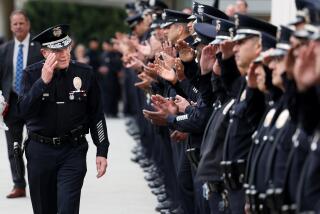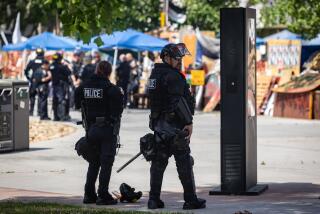LAPD’s approach to Occupy L.A. will be put to the test
- Share via
When the tents started spreading out across the City Hall lawn seven weeks ago, Los Angeles Police Chief Charlie Beck quickly realized that the Occupy L.A. protest could become a defining moment for his department.
Beck immediately made it his business to know what was going on inside the loosely organized movement. He talked frequently to several protest leaders on the telephone and kept in close contact with civil rights lawyers who were advising the demonstrators. His officers made a point of talking up protesters on the ground — and trying to ignore the smell of marijuana that wafted through the camp. On Thanksgiving Day, two LAPD commanders delivered turkeys to demonstrators.
The charm offensive was all leading up to Monday morning, when the LAPD may begin clearing out the camp.
Photos: Occupy protests go global
As police in New York and Oakland and at UC Davis and UC Berkeley have come under criticism for what some consider heavy-handed treatment of Occupy protesters, Beck said he’s determined for things to go more smoothly in Los Angeles. But he admits he’s not sure they will.
“I have no illusions that everybody is going to leave,” Beck said. “We anticipate that we will have to make arrests.... We certainly will not be the first ones to apply force.”
The stakes for Beck and his department are high.
The LAPD has a checkered record in dealing with protests. Clashes between officers and demonstrators at the 2000 Democratic National Convention brought a string of lawsuits and a series of reforms in how the department handles crowd control.
The city has paid out more than $12 million in civil settlements since officers used batons and fired foam bullets to disperse the crowd at a MacArthur Park rally for immigrant rights on May Day 2007. The incident, caught on video and broadcast around the world, was a black eye for the department and prompted another reform campaign.
Beck was appointed chief two years ago with the enthusiastic recommendations of civil rights groups and community activists, who said he brought a new way of thinking about defusing community tensions. Beck had worked with these groups in the aftermath of the Rampart corruption scandal a decade ago, supporting a series of reforms.
He has applied some of the same principles in his handling of Occupy L.A. But while some civil rights activists have praised LAPD restraint so far, some question why the department is forcing a showdown that could turn ugly.
Police “have been restrained up until now, but it’s not over,” said civil rights attorney Carol Sobel. The deadline, she said, “made people dig in their heels. There were discussions taking place. There was no reason not to let it play out further and see what the city could do.”
The chief has talked on and off with some protesters over the last few weeks, hoping they might agree to voluntarily vacate the lawn, and officials from the Police Department and the mayor’s office have met regularly with protesters. At one point, the city even offered the protesters a package of incentives that included downtown office space and land for gardening if they left. But on Friday, Mayor Antonio Villaraigosa announced that it was time for the encampment to end — and set a deadline of 12:01 a.m. Monday.
It’s a different tactic from the one used by New York police against Occupy Wall Street protesters earlier this month. There, officials kept the details of the eviction top secret and were later criticized for trying to keep the media away from the raid.
Beck said he believes being open is the best approach. But it does have risks.
By announcing when the crackdown will begin, the department risks confrontations by die-hard activists or provocateurs drawn to the site. Indeed, LAPD sources said they are worried less about the Occupy campers than about outsiders who might come to City Hall seeking conflict.
Among protesters, many believe the LAPD has been more cordial than police in other cities.
At some points, police have seemed to be almost overly cautious. Officers moved slowly to make arrests when a group of two dozen activists sat down with arms linked on Figueroa Street two weeks ago during a march organized by labor unions and community groups in conjunction with Occupy L.A. While an official LAPD videographer filmed the carefully choreographed arrests, several public relations officers stood by, ready to answer questions from the dozens of journalists who were watching.
Protester Ryan Rice, who was arrested in another protest later that day, said Los Angeles police were much less aggressive than those he encountered while being arrested during the Oakland police raid on the Occupy encampment there last month. He feels he was treated with “kid gloves” by Los Angeles police, something he credits not to progressive thinking among officers “but a political leash that’s holding them back.”
Veteran Los Angeles civil rights attorney and police reform advocate Connie Rice (no relation to Ryan Rice) agreed that the contrast with other cities has been notable.
During a visit to the Occupy Wall Street camp at Zuccotti Park a few weeks ago, Rice said, she was struck by the tense relationship between police and protesters.
She found the NYPD to be “hostile, bristling, intimidating, rude and purposely unhelpful, just like the LAPD used to be. People [there] were remarking why can’t NYPD be more like LAPD,” Rice said. “I said, ‘It took a lot of work.’”
There is a split within Occupy L.A. between those who think protesters should work with police and those who call it treason. Some criticized an Occupy leader who has served as liaison with police as being in collusion with authorities and called for the creation of a committee against police brutality.
At the camp Saturday, some said they believed eviction was now a foregone conclusion. The question was how many people would stay behind to resist, and whether they would do so peacefully.
Protester Clark Davis walked through the encampment and reminded people about the city’s deadline to move. He informed them about civil disobedience training taking place later in the day, and told them there would be an early evening screening of a documentary, “A Force More Powerful,” about international nonviolent resistance movements.
“The mood I’m getting is that everyone is pretty much ready for this thing and obviously they’re going to behave in a way they deem appropriate for this situation,” he said. “Most people are aware of what’s going on, and most people seem intent on not caving in and just surrendering and packing their stuff and getting out of here.”
PJ Davenport, another Occupy L.A activist, said she recently asked an LAPD commander why officers hadn’t already cleared the camp. The commander “said very succinctly that it would be a PR nightmare for the LAPD,” she said.
But Davenport said she knows both sides need to behave.
“If a person becomes violent, hopefully they’re quickly removed from the group, and we’ve asked for this all along, to remove any violence.”
Beck said he remained hopeful that the lawn could be cleared without violence.
“This is a police department that is very good with the application of force if we need to be. Nobody questions that,” he added. “But I also want to be known as a department that can avoid the application of major force.”
Photos: Occupy protests go global
More to Read
Sign up for Essential California
The most important California stories and recommendations in your inbox every morning.
You may occasionally receive promotional content from the Los Angeles Times.












